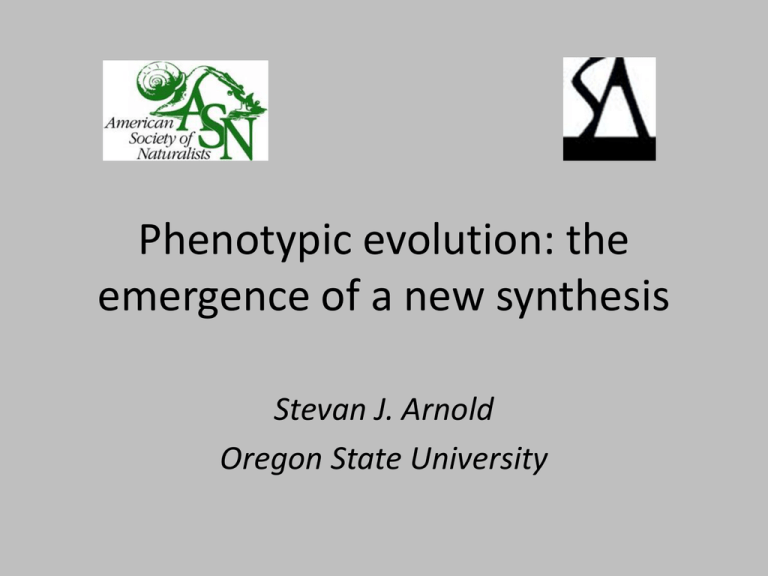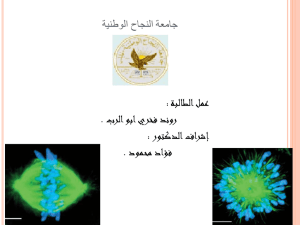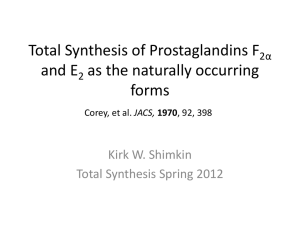Phenotypic Evolution - Oregon State University
advertisement

Phenotypic evolution: the emergence of a new synthesis Stevan J. Arnold Oregon State University Outline • Synthesis in evolutionary biology then and now • Simpson (1944) & the ongoing synthesis in evolutionary quantitative genetics • Two examples of the ongoing synthesis (Estes & Arnold 2007, Uyeda et al. 2011) • Conclusions & perspectives from the two studies • Some general lessons about synthesis in evolutionary biology Synthesis in evolutionary biology Cumulative number of citations of 57 influential books as a function of time Citations 200000 150000 100000 50000 0 1850 1900 Year 1950 2000 Synthesis 1930-32 (a) R A Fisher 1930 The genetical theory of natural selection..12,618 citations (b) S Wright 1931 Evolution in Mendelian populations…………... 5,493 (c) J B S Haldane 1932 The causes of evolution………………………. 1,463 Synthesis 1937-50 T Dobzhansky 1937 Genetics and the origin of species…….. 4,591 citations R Goldschmidt 1940 The material basis of evolution…….…. 1,009 E Mayr 1942 Systematics and the origin of species …………. 4,380 J Huxley 1942 Evolution, the modern synthesis………………. 1,891 G G Simpson 1944 Tempo and mode in evolution…………… 1,684 I I Schmalhausen 1949 Factors of evolution …………..…..…… 841 G L Stebbins 1950 Variation and evolution in plants………… 3,506 Dobzhansky Goldschmidt Mayr Huxley Simpson Schmalhausen Stebbins Synthesis in evolutionary biology An ongoing process since 1859, especially now! Cumulative number of citations of 57 influential books as a function of time Citations 200000 150000 100000 50000 0 1850 1900 Year 1950 2000 Simpson’s 1944 synthesis • Population genetics meets paleontology … evolution in deep evolutionary time • Reliance on case studies • Qualitative use of theory • Use of graphical models (e.g., adaptive landscape for phenotypic traits) Simpson’s concept of quantum evolution Simpson’s concept of quantum evolution Ongoing synthesis in evolutionary quantitative genetics • Quantitative genetics provides a theoretical framework with direct connections to data • Key concepts rendered in statistical terms • Mega-data sets reveal evolutionary patterns • Test alternative models in ML framework Two examples of ongoing synthesis Suzanne Estes & S J Arnold 2007 Resolving the paradox of stasis: models with stabilizing selection explain evolutionary divergence on all timescales. American Naturalist Suzanne Estes Two examples of ongoing synthesis Josef C Uyeda, Thomas F Hansen, S J Arnold & Jason Pienaar 2011 The million-year wait for macroevolutionary bursts. PNAS USA Josef Uyeda Thomas Hansen Jason Pienaar The approach • Make data and theory communicate (Plot your data!) • Compile abundant, high quality data (necessarily univariate) • Compile a priori estimates of key parameters: population size, inheritance, selection • Use the most powerful stochastic models of phenotypic evolution, cast in terms of key parameters • Confront the models with data (cross-check with parameter estimates) A priori estimates of key parameters Heritability n=580 D Roff, pers com Derek Roff Stabilizing selection Distance to optimum n=355 n=197 Kingsolver et al. 2001 Joel Kingsolver Kingsolver et al. 2001 A short digression to talk about stochastic models of phenotypic evolution If replicate lineages obey the same stochastic rules, we can statistically characterize the distribution of trait means of those replicates at any generation in the future. Joe Felsenstein Russ Lande Mike Lynch A short digression to talk about stochastic models of phenotypic evolution For example, in the case of drift with no selection, the mean at a particular generation is the sum of two parts: (a) the mean in the preceding generation (b) deviation due to parental sampling, a normally distributed variable with zero mean and a variance equal to G/Ne , where G is genetic variance and Ne is effective population size A short digression to talk about stochastic models of phenotypic evolution If drifting replicate lineages obey the same stochastic rules, we can statistically characterize the distribution of lineage trait means at any generation, t, in the future. In this particular case, the replicate trait means will be normally distributed with zero mean and a variance equal to tG/Ne. Lineage mean A simulation of a single lineage evolving by drift Time (generations) A simulation of 100 lineages evolving by drift Lineage mean ± 99% confidence limits Time (generations) Testing models with the Gingerich data • The data (sources, pattern) • The models (drift, models with a stationary optimum, models with a moving optimum) • Conclusions Estes & Arnold 2007 Testing models with the Gingerich data • The data (sources, pattern) • The models (drift, models with a stationary optimum, models with a moving optimum) • Conclusion Andrew Hendry Philip Gingerich Michael Kinnison Estes & Arnold 2007 Testing models with the Gingerich data • The data (sources) Longitudinal data: 2639 values for change in trait mean over intervals ranging from one to ten million generations; 44 sources, time series. Traits: size and counts; dimensions and shapes of shells, teeth, etc.; standardized to a common scale of within-population, phenotypic standard deviation. Taxa: foraminiferans … ceratopsid dinosaurs. … Estes & Arnold 2007 A short digression to talk about the data plots Mean body size at generation 0 = 100 mm Mean body size at generation 100 = 150 mm Average within-population std dev in body size = 10 mm Divergence = 150 mm - 100 mm = 50 mm or 5 sd Interval = 200 = 102 generations A short digression to talk about the data plots Mean body size at generation 0 = 100 mm Mean body size at generation 100 = 150 mm Average within-population std dev in body size = 10 mm Divergence = 150 mm - 100 mm = 50 mm or 5 sd Interval = 200 = 102 generations Testing models with the Gingerich data • The data (pattern): 99% confidence ellipse Estes & Arnold 2007 Testing models with the Gingerich data (Estes & Arnold 2007) • The data (pattern): ± 6 within-pop pheno sd Estes & Arnold 2007 When models confront the data, they can fail in three ways 1. Under-prediction: no points here Estes & Arnold 2007 When models confront the data, they can fail in three ways 2. Blowout: lots of points here Estes & Arnold 2007 When models confront the data, they can fail in three ways 3. Fails parameter cross-check: requires unrealistic values Estes & Arnold 2007 Testing models with the Gingerich data Conclusion: When representatives of the entire family of existing stochastic process models confront the data, only a single model is left standing. Drift (Brownian motion) Stationary optimum (OU) Fluctuating optimum (Brownian motion or white noise) Moving optimum (with white noise) Peak shift (drift from one optimum to another) Genetic constraints with any of the above Displaced optimum model Estes & Arnold 2007 Displaced optimum model Response of one lineage mean Model of peak movement Lande 1976 Displaced optimum model Lineage mean Multiple lineages chasing displaced optima could easily fill an adaptive zone Time (generations) Lande 1976 Testing models with the Uyeda et al data • The data (sources, pattern) • The models: white noise fluctuation of the trait mean combined with three models of moving optima (Brownian motion, singleburst, multiple-burst) • Conclusions Uyeda et al 2011 Testing models with the Uyeda et al. data The data (sources) Size-related traits: over 8,000 data points from 206 studies. Three sources: (i) microevolutionary time series, (ii) fossil time series, (iii) data from time-calibrated trees. Vertebrate taxa: mammals, birds, squamates. Uyeda et al 2011 A hypothetical data point on the new plotting axes ±65% change in body size “The Blunderbuss Pattern” Testing models with the Uyeda et al data • The data (sources, two parts to the barrel of the blunderbuss) • The models (white noise = the base of the barrel, models with moving optima = the flared end of the barrel: Brownian motion, single-burst model, multiple-burst model • Conclusions Uyeda et al 2011 Modeling strategy • Account for the long barrel of the blunderbuss with a surrogate process (white noise fluctuation of the lineage mean about the trait optimum) • Compare 3 alternative models to account for the flared end of the blunderbuss (Brownian motion and two descendants of the displaced optimum model). • The 2 descendants: single- and multiple burstmodels. Uyeda et al 2011 Simulations of the single-burst model Lineage mean (peak movement, evolution of the lineage mean) A single lineage Lineage mean Time (generations) Multiple lineages Time (generations) Uyeda et al. 2011 Simulation of the multiple-burst model (peak movement, evolution of the lineage mean) Lineage mean A single lineage Time (generations) Uyeda et al. 2011 Model comparisons White noise parameter estimate ( σ ) AIC* White noise (WN) only 0.20 −2940.53 Brownian motion + WN 0.11 −7877.97 Single-burst + WN 0.10 −9018.0 Multiple-burst + WN 0.10 −9142.54 Model Model comparisons White noise parameter estimate ( σ ) AIC* White noise (WN) only 0.20 −2940.53 Brownian motion + WN 0.11 −7877.97 Single-burst + WN 0.10 −9018.0 Multiple-burst + WN 0.10 −9142.54 Model Multiple-burst model: parameter estimates White noise distribution (dashed) Burst size distribution (solid) Burst timing distribution (mean time between bursts = 25 my) Probability Probability Conclusions & perspectives from the two studies • Micro- and meso-evolution is bounded. • What is the best model of that bounded evolution? • Evolutionary bursts are rare but increasingly inevitable in deep evolutionary time. • Is the blunderbuss pattern general? • Are invasions of new adaptive zones responsible for evolutionary bursts and hence the flared barrel of the blunderbuss? • What triggers those bursts/invasions? Synthesis in evolutionary biology • An ongoing activity since 1859 • Contention and bickering is normal • To synthesize, we need to bridge between fields • Data should talk to theory & vice versa • An extraordinary burst of synthesis is happening right now! What about your synthesis? Acknowledgements Research collaborators: Suzanne Estes, Josef Uyeda, Thomas Hansen, Jason Pienaar, Phil Gingerich, Andrew Hendry, Michael Kinnison, Russell Lande, Adam Jones, Reinhard Bürger … and all of you! NESCent course collaborators: Joe Felsenstein, Trudy Mackay, Adam Jones, Jonathan Losos, Luke Harmon, Liam Revell, Marguerite Butler, Josef Uyeda, Matt Pennell NSF OPUS program: Mark Courtney Editor/publisher: Trish Morse, Andy Sinauer






